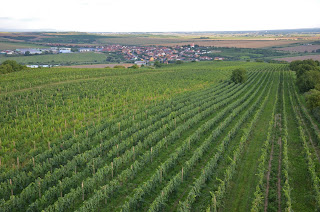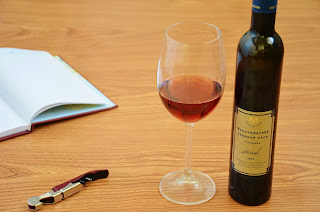The Czech Republic has a demanding colder climate conditions therefore there wasn't any suitable grape variety with muscat aroma. This gap in the wine market was filled in 1987 when Moravian Muscat was breeded by V. Krivanek. It is a cross of Muscat Ottonel and Prachttraube and the cultivar has gained wide popularity becoming the most grown local variety. Nowadays it is planted on more than 400 ha of vineyards. It is early ripening grape harvested at the same time as Müller Thurgau, therefore it can be used for young St. Martin's wine. It is suitable also for blends and sparkling wines.
Moravian Muscat 2015
semi-dry
Spätlese
12,5% alc.
residual sugar: 17,5 g/l
acids: 7,1 g/l
Moravia region, Mikulov subregion
This Moravian Muscat comes from the winery Mikrosvin Mikulov in the Mikulov subregion. The processing of grapes and production of wine from Moravian Muscat is highly demanding both in the vineyard and in the cellar. The variety is suitable only for cold areas and the yields should be reduced to obtain high quality grapes. The cultivar contains low amount of acids therefore it is necessary to harvest the grapes in time and process them by low temperatures with intent to preserve the acidity.
Light yellow colored wine with glints of white gold, after the first swirl the wine reveals captivating intensive aroma of muscat fresh grapes, tangerine, lychee, linden blossom, honey, rose and other flower notes. Although the aroma is very sweet, the palate surprises with lively acidity which makes the taste balanced and full. Notes of tangerine, peach, lychee, orange zest, black currant and a spicy hint of nutmeg is lingering into sweet tones of honey and banana.
This wine is very seductive and attractive especially for women. Above all, it makes you think such intensive perfume of this wine could not be done by mother nature. This bottle is a perfect example how great wine Moravian Muscat can be when processed carefully. Moravian Muscat should be enjoyed within two years after vintage, it is not suitable for archiving.
This wine is very seductive and attractive especially for women. Above all, it makes you think such intensive perfume of this wine could not be done by mother nature. This bottle is a perfect example how great wine Moravian Muscat can be when processed carefully. Moravian Muscat should be enjoyed within two years after vintage, it is not suitable for archiving.
Moravian Muscat 2015 comes from the collection FLOWER LINE which connects wines carrying joy and optimism, produced with an intent to emphasize the primary varietal aromatics, intense fruits, freshness and crispiness. Furthermore this characteristic is supported by eye-catching paintings of wild flowers on the label, attracting mainly women customers.
From the FLOWER LINE collection you can try also Kerner 2015 or Riesling 2014.
Follow Check Czech Wine to get more reviews!
Follow our Facebook: https://www.facebook.com/checkczechwine
View more photos on our Instagram: https://www.instagram.com/checkczechwine/
Visit our website to see wines we offer: http://www.winehills.eu













































